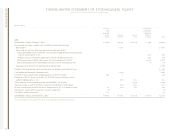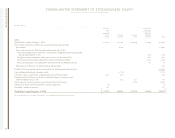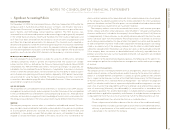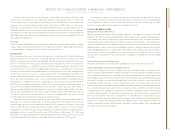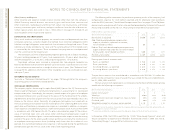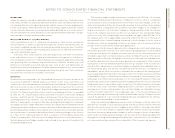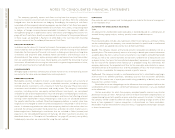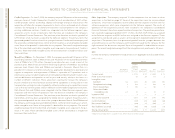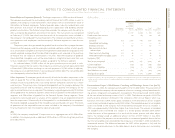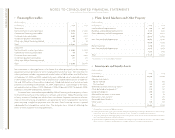IBM 2004 Annual Report Download - page 54
Download and view the complete annual report
Please find page 54 of the 2004 IBM annual report below. You can navigate through the pages in the report by either clicking on the pages listed below, or by using the keyword search tool below to find specific information within the annual report.
NOTES TO CONSOLIDATED FINANCIAL STATEMENTS
International Business Machines Corporation and Subsidiary Companies
52
ibm annual report 2004
Other (Income) and Expense
Other (income) and expense includes interest income (other than from the company’s
Global Financing external business transactions), gains and losses from securities and
other investments, realized gains and losses from certain real estate activity, and foreign
currency transaction gains and losses, and gains and losses from the sale of businesses.
Certain special actions discussed in note s, “2002 Actions” on pages 73 through 76 are
also included in Other (income) and expense.
depreciation and amortization
Plant, rental machines and other property are carried at cost and depreciated over their
estimated useful lives using the straight-line method. Asset retirement obligations (ARO)
liabilities are legal obligations associated with the retirement of long-lived assets. These
liabilities are initially recorded at fair value and the carrying amount of the related assets
is increased by the same amount. These incremental carrying amounts are depreciated
over the useful lives of the related assets.
The estimated useful lives of depreciable properties generally are as follows: buildings,
50 years; building equipment, 20 years; land improvements, 20 years; plant, laboratory
and office equipment, 2 to 15 years; and computer equipment, 1.5 to 5 years.
Capitalized software costs incurred or acquired after technological feasibility has
been established are amortized over periods up to three years. Capitalized costs for inter-
nal-use software are amortized on a straight-line basis over 2 years. (See “Software Costs”
on page 55 for additional information.) Other intangible assets are amortized over peri-
ods up to 7 years.
retirement-related benefits
See note w, “Retirement-Related Benefits,” on pages 78 through 86 for the company’s
accounting policy for retirement-related benefits.
stock-based compensation
The company applies Accounting Principles Board (APB) Opinion No. 25, “Accounting for
Stock Issued to Employees,” and related interpretations in accounting for its stock-based
compensation plans. Accordingly, the company records expense for grants of employee
stock-based compensation awards equal to the excess of the market price of the underly-
ing IBM shares at the date of grant over the exercise price of the stock-related award, if any
(known as the intrinsic value). Generally, all employee stock options are issued with an
exercise price equal to or greater than the market price of the underlying IBM shares at the
grant date and therefore, no compensation expense is recorded. In addition, no compen-
sation expense is recorded for purchases under the Employees Stock Purchase Plan (ESPP)
in accordance with APB Opinion No. 25. This plan is described on page 78. The intrinsic
value of restricted stock units and certain other stock-based compensation issued to
employees as of the date of grant is amortized to compensation expense over the vesting
period of the grant. To the extent awards contain performance criteria that could result in
an employee receiving more or fewer (including zero) shares than the number of units
granted, the unamortized compensation expense is remeasured during the performance
period based upon the intrinsic value at the end of each reporting period.
The following table summarizes the pro forma operating results of the company, had
compensation expense for stock options granted and for employee stock purchases
under the ESPP (see note v, “Stock-Based Compensation Plans” on pages 77 and 78), been
determined in accordance with the fair value method prescribed by Statement of Financial
Accounting Standards (SFAS) No. 123, “Accounting for Stock-Based Compensation.”
(Dollars in millions except per share amounts)
FOR THE YEAR ENDED DECEMBER 31: 2004 2003 2002
Net income as reported $«8,430 $«7,583 $«3,579
Add: Stock-based employee compensation
expense included in reported net income,
net of related tax effects 129 76 112
Deduct: Total stock-based employee compensation
expense determined under the fair value method
for all awards, net of related tax effects 1,080 1,101 1,315
Pro forma net income $«7,479 $«6,558 $«2,376
Earnings per share of common stock:
Basic— as reported $«««5.03 $«««4.40 $«««2.10
Basic— pro forma $«««4.47 $«««3.81 $«««1.40
Assuming dilution— as reported $«««4.93 $«««4.32 $«««2.06
Assuming dilution— pro forma $«««4.38 $«««3.74 $«««1.39
The pro forma amounts that are disclosed in accordance with SFAS No. 123 reflect the
portion of the estimated fair value of awards that was earned for the years ended Decem-
ber 31, 2004, 2003 and 2002.
The fair value of stock option grants is estimated using the Black-Scholes option-pricing
model with the following assumptions:
FOR THE YEAR ENDED DECEMBER 31: 2004 2003 2002
Option term (years)*555
Volatility** 37.8% 39.9% 40.4%
Risk-free interest rate (zero coupon U.S. treasury note) 3.5% 2.9% 2.8%
Dividend yield 0.8% 0.7% 0.7%
Weighted-average fair value per option granted $«««34 $«««30 $«««28
*The Option term is the number of years that the company estimates, based upon history, that options will be out-
standing prior to exercise or forfeiture.
** To determine volatility, the company measures the daily price changes of the stock over the option term.
In December 2004, the FASB issued SFAS No. 123(R), “Share-based Payment,” which will
require companies to expense costs related to share-based awards in 2005. See note b,
“Accounting Changes” on page 55 for further discussion.






